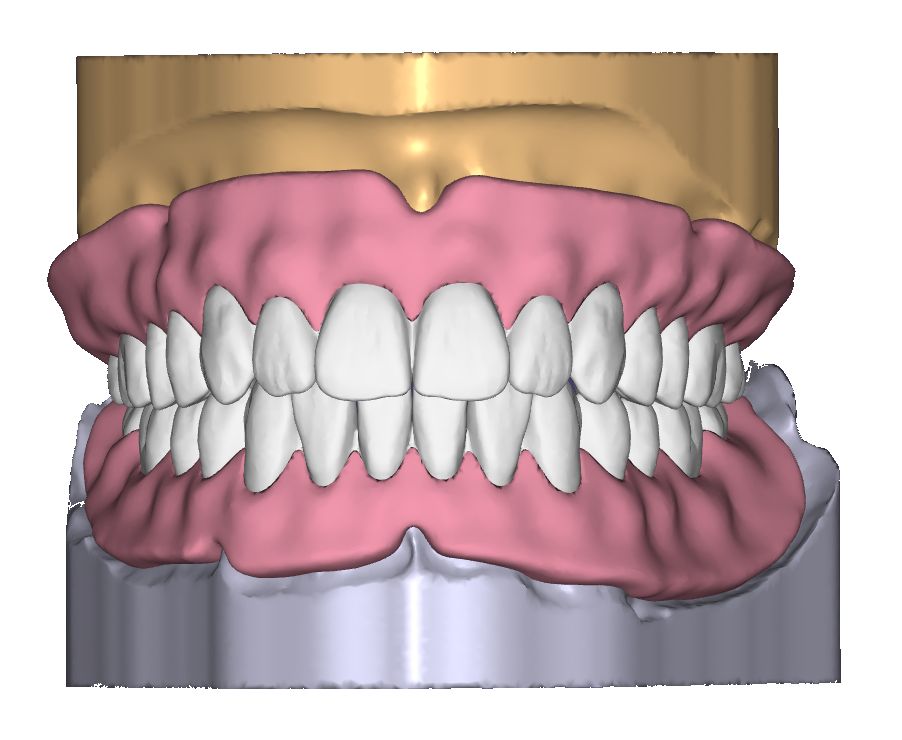Case Planning for Ivotion Digital Implant-Supported Overdenture
Technical treatment planning is a preliminary procedure that demands clinical and technical communication and collaboration. This collaborative analysis of the acquired intra-oral scan data of terminal dentition and soft tissue anatomy is critical to achieving a successful prosthetic outcome. To achieve optimal outcomes for an edentulous patient, complete digital denture prosthetics should be treatment-planned and designed to replace lost bone, tissue, and dentition while restoring function, aesthetics, and phonetics. Establishing a definitive digital technical treatment plan with case sequencing procedures and appointments creates predictable success with complete prosthetics.
After this prosthetic data analysis, the clinician and technician should have enough information to design provisional and definitive digital dentures to provide the patient with a successful solution.
The prosthetic plan for the presented case is to extract the remaining terminal dentition and then place implants for maxillary and mandibular implant-supported prostheses. This blog offers a unique way to plan prosthetic cases from an Intra-oral scan using STL design files to improve case presentation and communication between dentist and patient.
Prosthetic Problem:
Decreased Vertical Dimension of Occlusion due to missing maxillary and mandibular anterior and posterior teeth
Missing anterior maxillary teeth eliminate a reference for tooth size and placement
A bite scan is taken in centric occlusion at the collapsed vertical dimension of occlusion
Patient Desires Maxillary and Mandibular Implant-Supported Prostheses
Prosthetic Variables:
Vertical Dimension of Occlusion
Maxillary and mandibular relationship
Incisal edge position
Prosthetic space
Implant placement
Prosthetic Design Solutions:
Increase VDO to an average of 42mm intra-vestibular
Reduce maxillary and mandibular residual ridges by 4mm anterior and 3mm posterior
Arrange teeth using existing terminal dentition as reference for tooth placement in design for immediate conversion denture
Fig. 1
The Intra-Oral Scans are received then data is analyzed for the following:
Soft-tissue anatomy
Maxillo-mandibular ridge relationship
Prosthetic Space
Terminal dentition
Bone height
Fig. 2
With Prosthetic space analysis, the Vertical Dimension of Occlusion or inter-residual space is evaluated to provide adequate space for the definitive digital prosthesis. When re-establishing the VDO or prosthetic space, the inter-residual ridge space must be increased to allow for the design of the acrylic-resin base, implant bar, and denture teeth. According to the intra-vestibular measurement of scans, a 28.49 mm bite scan must be increased to at least 40mm. In design, a 12.50 mm increase is requested, which will provide a 41 mm intra-vestibular ridge relationship.
Fig. 3
In design, model bases (maxillary gold and mandibular silver) are built to Intra-Oral Scan STL files (green).To ensure proper registration between the base and scan, the speckled areas are visible on residual ridges illustrating a good match between data in the scan and base.
Fig. 4
The terminal dentition is virtually extracted with a 4mm anterior and 3mm posterior tissue and bone reduction to create prosthetic space within the intra-residual ridge relationship. For implant-supported prosthetics case planning, 15mm per arch from ridge crest to incisal edge needs to be factored into the design.
Fig. 5
The denture tooth mold is selected then teeth are arranged using terminal dentition (green) and anatomical soft tissue landmarks as a reference or guide for placement of prosthetic tooth arrangement.
Fig. 6
Looking at the maxillary arch from the occlusal perspective, the denture tooth (white) position can be evaluated in relation to the residual ridge and terminal dentition reference (green). Note the relationship of canine to clinical crown and roots providing symmetry in design for an esthetic and functional arrangement.
Fig. 7
The mandibular arch from an occlusal perspective shows the relationship of posterior denture teeth (white) to the residual ridge crest and terminal dentition reference (green). The middle is maintained and used for maxillary arch anterior tooth arrangement.
Fig. 8
Denture bases are built-in designs with proper gingival contours for margins, interdental papillae, festooning, and border extensions.
This digital workup of Intra-oral scans is an excellent and effective tool for case evaluation and patient presentation when transitioning your patient from terminal dentition to complete digital prosthetics.
For more information on this unique digital workflow, contact customer service at MicroDental Laboratories.
About the author
Robert Kreyer, CDT is a third-generation Dental Technician who received his training from the US Army Medical Field Service School in 1971. He is a member of the American Prosthodontic Society, a Fellow of The International Congress of Oral Implantologists, and the past Chair of The American College of Prosthodontists Dental Technician Alliance. Mr. Kreyer received certification from Ivoclar Vivadent as a Biofunctional Prosthetic System (BPS) Technical Instructor as well as from Candulor in Zurich, Switzerland as their Course Instructor.
Robert owned and operated Kreyer Dental Prosthetics from the years 1975 to 2010. In 2010, Robert Kreyer was the first recipient of The American College of Prosthodontists Dental Technician Leadership Award. In 2011, he was selected by the National Board of Certification in Dental Technology as their CDT of the Year. In 2014, Robert Kreyer received the Rudd Award from the Editorial Council of The Journal of Prosthetic Dentistry. He is currently the Director of Removables Prosthetics at MicroDental Laboratories where he focuses on research and development and digital workflows.










